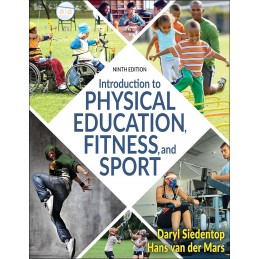The ninth edition of Introduction to
Physical Education, Fitness, and Sport is as robust and instrumental as ever for students preparing for careers in the various physical activity fields. And the latest version of this long-running and seminal text is chock-full of new material for budding teachers, coaches, fitness professionals, recreation leaders, and program leaders.
This book covers a broad spectrum of careers and professions, including those in physical education, health, dance, fitness, sport, recreation, athletic training, and athletic administration. The authors provide an overview of the respective professions and offer a deep dive into individual careers. In addition, the text explores the role of public policy across local, state, and federal levels, noting how various physical activity professions are affected by regulations.
New content in this edition includes the following::
- Five new chapters cover dance education, recreational leadership, health education, contemporary physical education curriculum models, and exemplary physical education programs.
- Updated content on how economic, racial, and ethnic disparities affect physical activity and physical activity professions will help students anticipate real-life issues.
- New evidence, data, and information throughout the text will help students understand the issues, problems, and programmatic solutions in the various fields as they prepare to meet and solve those problems.
- The expanded and updated physical education chapters reflect current trends and developments.
The new chapters on dance education, recreational leadership, and health education broaden the books scope as they show the role these allied physical activity professions play in the larger efforts to promote and support physical activity as a way to create a healthy citizenry.
All chapters throughout the text have been updated to reflect the most current information on the topics. And the books web-based ancillaries, which include a range of instructor tools, have also been revised and expanded.
Introduction to Physical Education, Fitness, and Sport is organized into six parts::
- Part I provides a thorough understanding of the health issues related to physical inactivity and of the evolution of physical activity programs.
- Parts II, III, and IV focus on concepts, programs, professions, and barriers to overcome in physical education, fitness, and sport, respectively.
- Part V delves into the allied physical activity professions of dance and dance education, recreation, and health education, exploring the concepts, professions, and issues in each area.
- Part VI tackles the subdisciplines of kinesiology that support physical activity, such as exercise physiology, sport pedagogy, sport and exercise psychology, sport philosophy, biomechanics, and more.
Introduction to Physical Education, Fitness, and Sport will help students make more informed career choices, understand the professional issues they will face, and be in a better position to develop high-quality programs and make those programs widely available.
Ultimately, this book will help new generations of physical activity professionals provide positive solutions to the problems that exist in their fields and to make lifelong impacts on their students.


 Dostawa
Dostawa
 Płatność
Płatność
 Zwroty
Zwroty
